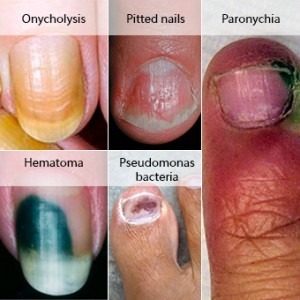 Nail disorders comprise 10% of dermatologic conditions. Nutrition can have an effect on the health of fingernails and sometimes we can make a determination about nutritional or health status by examining a person’s fingernails.
Nail disorders comprise 10% of dermatologic conditions. Nutrition can have an effect on the health of fingernails and sometimes we can make a determination about nutritional or health status by examining a person’s fingernails.
Onychorrhexis, (on-e-ko-REX-is) or senile nail, describes longitudinal ridges in the nail plate (fingernail) that are often associated with the aging process and is also strongly correlated with rheumatoid arthritis. Mineral imbalances leading to onychorrhexis include iron-deficiency anemia and zinc deficiency. Zinc deficiency can also manifest as white spots on a single or multiple fingernails.
Twenty percent of the adult population has brittle nails, with women affected more than men. There are a number of nutritional interventions that can help with this. Biotin is a supplement that has been found to be helpful for nails that are brittle, weak, thin or that tend to split easily. In veterinary medicine, biotin supplements are known to improve defects in the hooves of horses and pigs. Two uncontrolled trials have shown that biotin supplementation also increases the strength of human nails. Zinc and magnesium can also be beneficial. Doses of zinc were 17-34 mg daily and magnesium doses were 10-20 mg daily. Gelatin has been a popular recommendation for soft or weak nails. Several clinical trials have found gelatin to be an effective treatment, however, gelatin is an incomplete protein, which has the potential to cause mild amino acid imbalance, particularly in people consuming a low protein diet. Therefore, it might be best to reserve gelatin therapy for patients who have not responded to other treatments.
Other conditions that can show up as defective fingernails include iron-deficiency anemia, which manifests as brittle, fragile, longitudinally ridged or lamellated (composed of thin plates or scales) nails. Arsenic poisoning can also contribute to the development of longitudinal ridges in the fingernails.
In good health,
Lucinda
